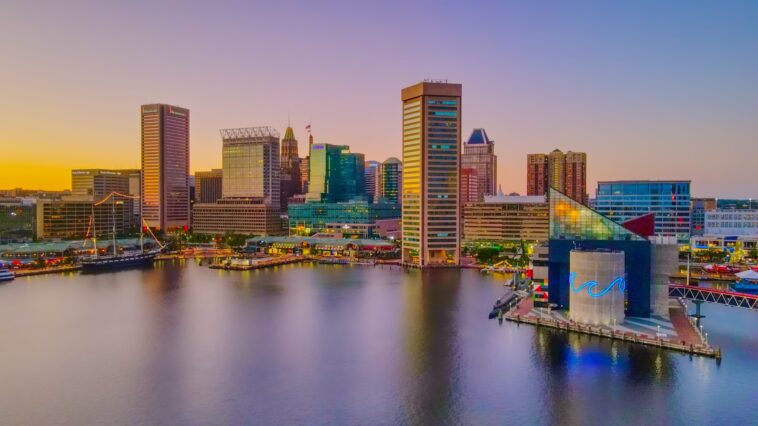Baltimore stands as Maryland‘s largest city and ranks 24th in size among cities in the United States. This significant urban center finds its home in Maryland’s central region, nestled along the Patapsco River’s tidal section, which is a tributary of the expansive Chesapeake Bay. Unique in its governance, Baltimore is an independent city, a status that sets it apart from the adjacent Baltimore County, often leading to the use of “Baltimore City” in references to distinguish it from the county.
Geographical and Historical Insights
Geography and Climate
Baltimore’s location is not just a geographical marker but a blend of natural and urban landscapes. The city is strategically situated near the Chesapeake Bay, making it a pivotal location for commerce and transportation. Its climate is typically classified as humid subtropical, characterized by hot summers and cool winters, an aspect that significantly influences the lifestyle and activities in the city.
Historical Evolution
Baltimore’s history is rich and varied. Founded in 1729, the city has been a witness to many pivotal events in American history. It played a significant role during the War of 1812, where the Battle of Baltimore was a key event, inspiring Francis Scott Key to write what would become the national anthem, “The Star-Spangled Banner.”
Economic and Cultural Landscape
Economy and Industry
Economically, Baltimore has transformed over the years. Historically, it was a major shipping and manufacturing hub, with its port being one of the most important on the East Coast. In recent years, the economy has diversified, with a strong emphasis on service-oriented industries, including healthcare, education, and finance. The presence of Johns Hopkins University and Hospital, a world-renowned institution, significantly contributes to the city’s economic and educational landscape.
Culture and Society
Culturally, Baltimore is a melting pot of diverse ethnicities and traditions. It is known for its distinct neighborhoods, each with its own unique character and history. The city is also a hub for the arts, with numerous museums, galleries, and performing arts venues. The Baltimore Museum of Art and the Walters Art Museum are notable institutions, hosting impressive collections that attract visitors from around the world.
Infrastructure and Urban Development
Transportation Systems
Baltimore’s transportation infrastructure is comprehensive, featuring an international airport, a major seaport, and an extensive network of highways and public transit options, including buses, light rail, and a subway system. This infrastructure supports both the local population and the city’s role as a key player in regional and national transportation.
Urban Planning and Development
Urban development in Baltimore has been a focus in recent years, with efforts aimed at revitalizing various areas of the city. Initiatives like the Inner Harbor redevelopment have transformed former industrial zones into vibrant, mixed-use spaces that cater to both residents and tourists.
Challenges and Opportunities
Socioeconomic Issues
Despite its progress and development, Baltimore faces its share of challenges. Socioeconomic disparities, urban decay in certain areas, and crime are issues that the city continues to grapple with. Addressing these concerns is crucial for the continued growth and well-being of Baltimore.
Future Prospects
Looking forward, Baltimore holds significant potential for growth and development. Its strategic location, rich history, and cultural diversity position it as a city with the opportunity to adapt and thrive in the changing landscape of urban America.
Conclusion
In summary, Baltimore is a city with a complex tapestry of history, culture, and modernity. It stands not only as a significant urban center in Maryland but also as a city of national importance in the United States. Its unique blend of historical significance, economic diversity, cultural richness, and urban challenges make it a fascinating subject of study and exploration.
Key Takeaways:
- Baltimore is Maryland’s largest city and the 24th largest in the U.S.
- It has a unique status as an independent city, distinct from Baltimore County.
- The city’s strategic location near the Chesapeake Bay has shaped its history and economy.
- Baltimore’s economy has evolved from manufacturing to service-oriented industries.
- The city is a cultural hub with diverse neighborhoods and a rich artistic scene.
- Ongoing urban development and revitalization efforts are shaping its future.
- Addressing socioeconomic challenges remains a priority for Baltimore’s continued growth.





